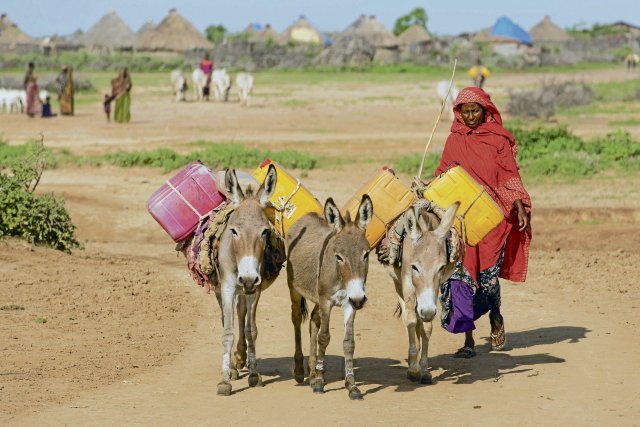In Ethiopia, women spend almost two hours a day fetching water.
Photo: imago/Stefan Trappe
Climate extremes and natural disasters caused by climate change particularly affect women and girls. In 2020, 130 studies on the consequences of climate change for men and women were evaluated, 68 percent of which considered women to be more affected. Three new publications show that climate change is endangering access to the health system and therefore reproductive rights for women and girls, leading to increased workloads for them and, in individual cases, increasing gender-based violence.
It was only at the end of May that the United Nations Population Fund (UNFPA) pointed out that women are once again particularly affected by extreme weather events. According to UNFPA data analysis, 41 million people – or six percent of the population – in coastal regions of Latin America and the Caribbean are exposed to life-threatening storms and floods. The analysis also shows that 1,448 clinics responsible for maternal health and family planning are located in low-lying coastal areas and therefore have a particularly high risk profile. In the island states of Aruba, the Cayman Islands and the Bahamas as well as Suriname and Guyana, 80 percent of all hospitals in coastal areas are only slightly above sea level. But there are also a large number of clinics close to the coasts in Brazil, Mexico, Haiti and Ecuador.
nd.DieWoche – our weekly newsletter

With our weekly newsletter nd.DieWoche look at the most important topics of the week and read them Highlights our Saturday edition on Friday. Get your free subscription here.
Hurricane “Beryl,” which hit the Caribbean island of Carriacou, which belongs to Grenada, on Monday and destroyed or damaged around 98 percent of all buildings there, makes it clear how real this warning is. There are reports of damaged schools, hospitals and police stations. Meanwhile, Beryl continued its course through the Caribbean and even strengthened to Category 5.
The US Institute for Oceanic and Atmospheric Research (NOAA) expects an “exceptional” hurricane season this year with up to seven storms of Category 3 or higher. One reason for this is high temperatures on the surface of the North Atlantic – a result of man-made climate change. The risk to clinics in coastal regions is increasing.
»Climate change hits women and girls the hardest and exacerbates existing inequalities. “Millions of poor and vulnerable women and girls, who are least responsible for the climate crisis, will pay a heavy price when climate-related disasters strike, destroying essential health and protection services and livelihoods,” UNFPA Director Natalia Kanem said in late May. The organization calls for more support for vulnerable countries in building climate-resilient health systems.
It’s not just storms and floods that are increasing due to climate change that are affecting the living conditions of women and girls worldwide. According to a report recently published in the journal Nature Study It is feared that by 2050 women will spend up to 30 percent more time fetching water due to climate change. In households without a drinking water connection – in which around two billion people live worldwide – it is usually women and girls who are responsible for this task. The researchers at the Potsdam Institute for Climate Impact Research (PIK) calculated that women in households without a water connection spent an average of 22.84 minutes per day obtaining drinking water. The basis for this was household surveys from 1990 to 2019. However, there were very large regional differences. In Indonesia, the women only needed four minutes to complete the task, but in Ethiopia, it took them almost two hours. »Compared to these figures, by 2050 women will have to spend up to 30 percent more time fetching water per day in a high-emissions scenario. This increase can be reduced to 19 percent if global warming is kept below two degrees Celsius,” says study author Robert Carr, visiting scientist at PIK. There are also regional differences in the future scenarios. To create these, the previously observed patterns of climate and water availability were combined with the temperature and precipitation forecasts from climate models, taking different emissions scenarios into account.
If it takes a long time to get water, this often means that women and girls have to face restrictions elsewhere. “Due to longer water collection times, they lose time for education, work and leisure,” explains co-author and PIK researcher Leonie Wenz. Economic losses from such lost working time could run into the tens to hundreds of millions of dollars per country per year.
A meta-study on gender, climate and environmental justice based on Australia also shows that women and transgender people are more affected by the climate crisis in many aspects. According to the organization Women’s Environmental Leadership Australia (Wela), 80 percent of those displaced by natural disasters are women.
“A study of several communities affected by bushfires found that the greater the devastation caused by the fire, the more likely violence against women was,” it says publication from Wela. And there has also been an increase in gender-based violence in connection with a once-in-a-century drought in the Murray-Darling Basin.
The recommendations that Wela makes for Australia are likely to have international validity. This includes, for example, bringing more women and gender-diverse people into leadership positions and linking climate and environmental policy more closely to issues of gender equality and vice versa. Gender aspects in connection with natural disasters should be better researched and taken into account in disaster preparedness and relief.
»Climate change hits women and girls the hardest.«
Natalia KanemUNFPA Director
Subscribe to the “nd”
Being left is complicated.
We keep track!
With our digital promotional subscription you can read all issues of »nd« digitally (nd.App or nd.Epaper) for little money at home or on the go.
Subscribe now!
